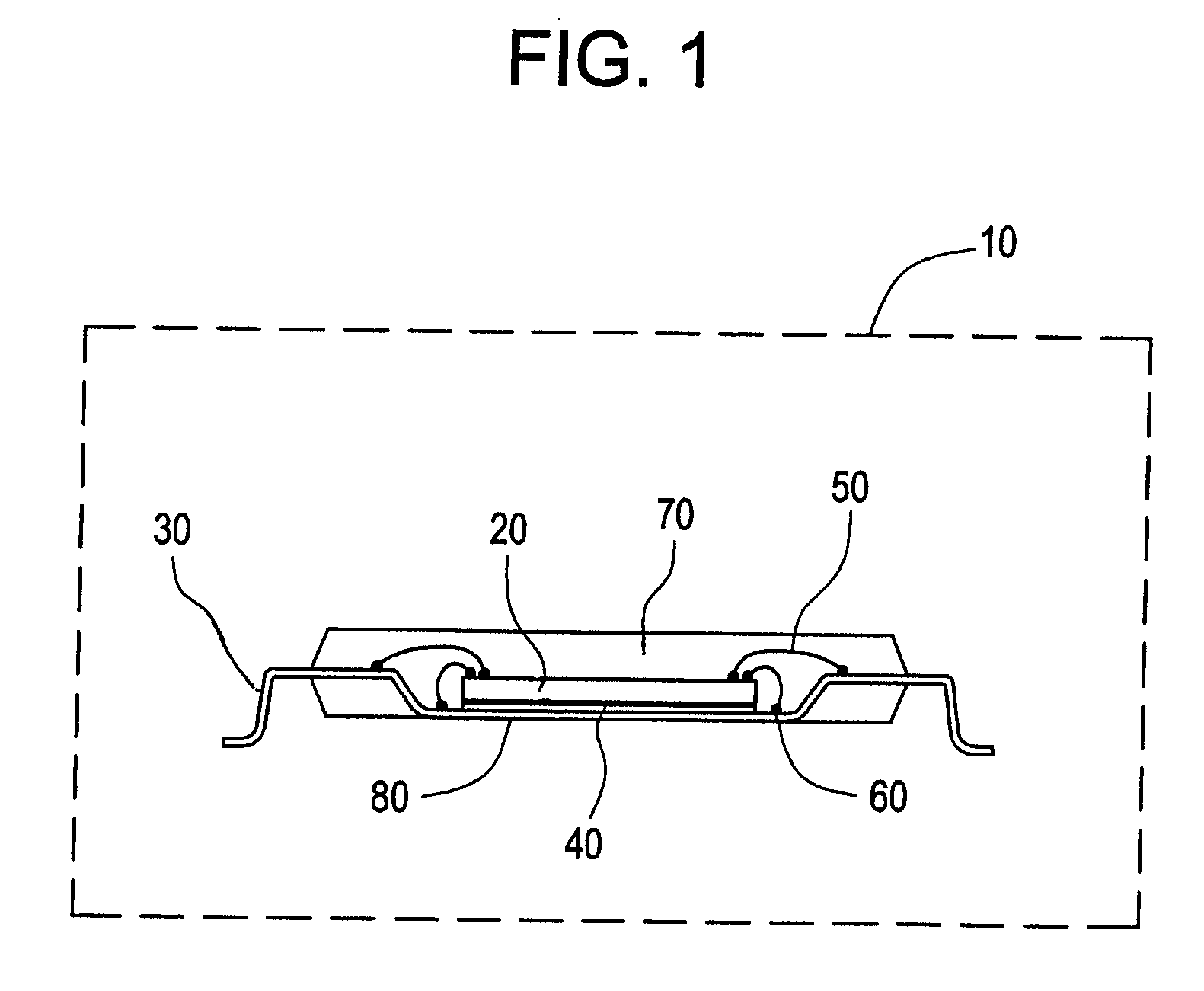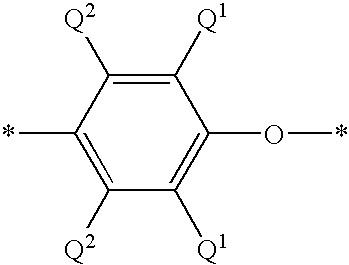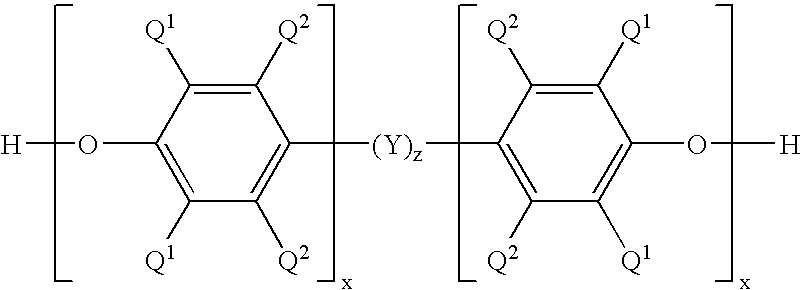Curable composition and method
a composition and composition technology, applied in the field of cureable composition and method, can solve the problems of reducing the cost of transportation, storage and waste, and reducing the durability of the cured encapsulation material
- Summary
- Abstract
- Description
- Claims
- Application Information
AI Technical Summary
Benefits of technology
Problems solved by technology
Method used
Image
Examples
examples 1-5
[0035] Table 1 presents the amounts of materials, expressed in parts by weight, combined to make Example Formulations 1-5. Example 1 had no polyphenylene ether. The other examples had poly(2,6-dimethyl-1,4-phenylene ether)s of different molecular weight (as measured by intrinsic viscosity (IV)). Examples 2-5 contained poly(2,6-dimethyl-1,4-phenylene ether)s of intrinsic viscosities 0.12, 0.20, 0.25, and 0.30, respectively. The polyphenylene ethers were passed through a 400 mesh sieve (opening size 37 micrometers) before formulation. “Denka FB570 silica” is a fused silica obtained from Denka having a median particle size of 17.7 micrometers and a surface area of 3.1 meter2 / gram. “Denka SFP silica” is a fused silica obtained from Denka having a median particle size of 0.7 micrometers and a surface area of 6.2 meter2 / gram. “Epoxy Silane”, obtained from GE Advanced Materials, is 2-(3,4-epoxycyclohexyl)-ethyl-trimethoxysilane. “Yuka RSS1407LC epoxy”, obtained from Yuka Shell, is 3,3′,5,5...
examples 6-8
[0044] The formulations in Table 3 were mixed, molded, and tested as described for Examples 1-5. “Sumitomo ECN-195XL-25”, obtained from Sumitomo Chemical, is an epoxidized ortho-cresol novolac resin. Example 6 did not contain polyphenylene ether. Examples 7 and 8 contained poly(2,6-dimethyl-1,4-phenylene ether) resins with intrinsic viscosities of 0.12 and 0.30, respectively.
TABLE 3IngredientExample 6Examples 7 & 8Denka FB570 Silica1494.001494.00Denka SFP Silica166.00166.00Epoxy Silane9.749.74Yuka RSS1407LC Epoxy214.82182.59Sumitomo ECN-195XL-2592.0678.25OPPI7.677.67Benzopinacole4.604.60Polyphenylene ether046.03Carnauba Wax8.008.00Carbon Black4.004.00
[0045] Table 4 shows the results obtained for Examples 6-8. The results show that the poly(arylene ether)-containing Examples 7 and 8 exhibit reduced moisture absorption and increased copper adhesion relative to Example 6 without poly(arylene ether).
TABLE 4TestEx. 6Ex. 7Ex. 8Spiral Flow (cm)105.493.563CTE1 (ppm / ° C.)141313CTE2 (ppm / ...
examples 11-14
[0048] Four compositions varying in the type and amount of added poly(arylene ether) were prepared. Example 11 contained no poly(arylene ether), Example 12 contained “bifunctional” poly(2,6-dimethyl-1,4-phenylene ether) having an intrinsic viscosity of 0.12 deciliters per gram, Example 13 contained poly(2,6-dimethyl-1,4-phenylene ether) having an intrinsic viscosity of 0.086 deciliters per gram, and Example 14 contained poly(2,6-dimethyl-1,4-phenylene ether) having an intrinsic viscosity of 0.064 deciliters per gram. The formulations were initially prepared in two parts. The first part contained the following components: 229.50 grams FB570 spherical fused silica from Denka, 25.50 grams of SFP30 spherical fused silica from Denka, 0.90 grams of MICHEM® Wax 411 from Michelman, and 0.60 grams of Cabot BLACK PEARLS® 120. The poly(arylene ether)-containing compositions further contained 6.44 grams of the specified poly(arylene ether) in micronized form (i.e., passed through a 400 mesh sie...
PUM
| Property | Measurement | Unit |
|---|---|---|
| softening point | aaaaa | aaaaa |
| equivalent spherical diameter | aaaaa | aaaaa |
| particle size | aaaaa | aaaaa |
Abstract
Description
Claims
Application Information
 Login to View More
Login to View More - R&D
- Intellectual Property
- Life Sciences
- Materials
- Tech Scout
- Unparalleled Data Quality
- Higher Quality Content
- 60% Fewer Hallucinations
Browse by: Latest US Patents, China's latest patents, Technical Efficacy Thesaurus, Application Domain, Technology Topic, Popular Technical Reports.
© 2025 PatSnap. All rights reserved.Legal|Privacy policy|Modern Slavery Act Transparency Statement|Sitemap|About US| Contact US: help@patsnap.com



